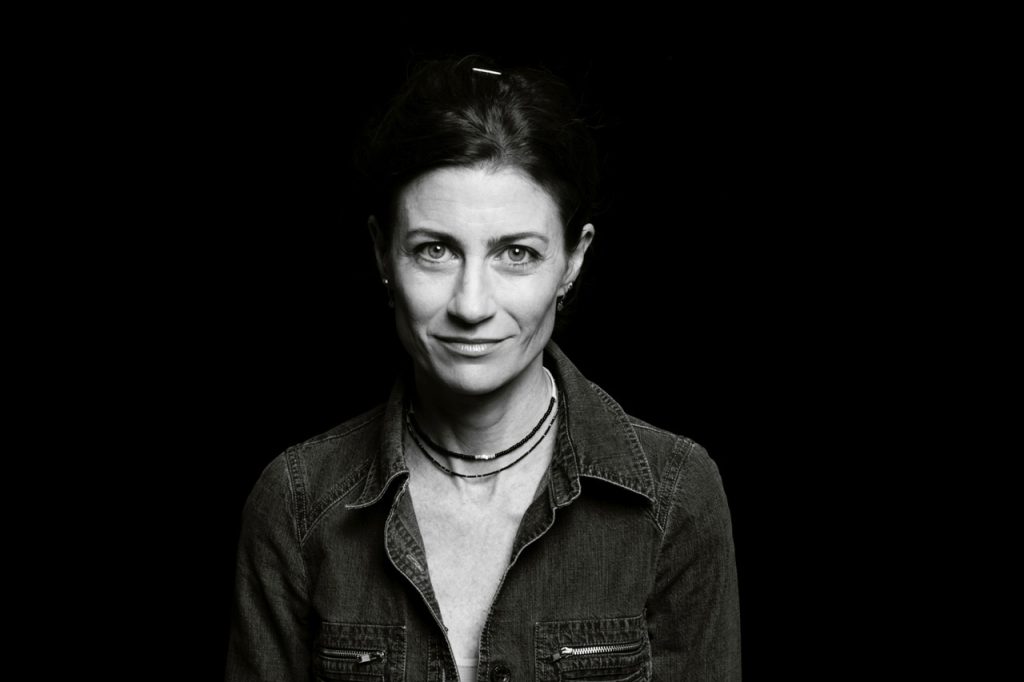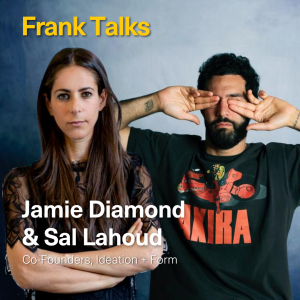We are thrilled to bring you this week’s Frank Talk with Fine Artist and Founder and Artistic Director of 4th Wall App, Nancy Baker Cahill! Nancy is an artist working at the intersection of fine art, new media and activism. 4th Wall is a free Augmented Reality (AR) public art platform exploring resistance and inclusive creative expression. Through 4th Wall, Nancy initiated Coordinates, an ongoing series of curated, collaborative, and site-specific AR public art exhibitions. Her solo AR public art installations include the Desert X Biennial (2019), Facebook’s Artist in Residency (2019), Liberty Bell for Art Production Fund (2020, six locations) and SXSW (2021). She is the recipient of an ARC Grant from the Center for Cultural Innovation and is one of ten artist scholars in the Berggruen Institute’s inaugural 2020 Transformations of the Human Fellowship. Nancy is a TEDx speaker and was the subject of a 2019 Bloomberg Media Art + Technology short documentary. In 2019, she received an “Impact Maker to Watch” award at LA City Hall and was named by the LA Times as one of the ARTS Faces of the Year. Please enjoy reading Nancy’s Frank Talk and download the 4th Wall app!
What was your first job in the Arts?
My first job was at WGBH in Boston writing descriptive narration of film and TV for the blind and visually impaired.
What was the most useful or important thing you learned at that job?
I learned the importance of accessible art, cogent writing, and the expressive and narrative power of sound.
Tell us a little more about yourself. When did you realize you wanted to pursue a career in this industry?
I have been an artist my entire life, and other than wanting briefly to be 1. Robin Hood and 2. a spy (my mother talked me out of that one), it is what I have always wanted. My plans took a long detour when I got married, moved to LA, and had children.
What do you do now?
I am a multidisciplinary artist and am the founder and artistic director of 4th Wall, a free, AR public art app.
Where are you from?
Boston, MA
What is the arts community like there?
I’m not certain as I’ve been in LA for over 25 years but I know that between Boston Cyberarts, MIT Media Lab and the Rose Kennedy Greenway, there is a robust art and technology and public art scene.
Has where you come from shaped what you do in the arts today?
Growing up in a Democratic-majority state, and having been politically active most of my life (my father was a local politician), I would say that civic and political engagement were values inculcated in me early on. I was also fortunate to attend a diverse public high school with an extremely rigorous arts program.
What is the best piece of advice you can give about working in the art world?
Ignore pre-established paradigms that support the status quo. Think outside the box.
What is one of your greatest accomplishments in your career so far?
In early 2018, with the help of my tech development team at Drive Studios, I founded and launched a free AR public art app called 4th Wall. I wanted to challenge notions of public art and to provide accessible, interactive AR art experiences to an unknown, unseen audience. I’m proud that it was the first app of its kind in terms of its UI and intended use. We designed 4th Wall to be as user-driven as possible and to reflect my hand-drawn aesthetic. We photogrammetried my studio in 360, recorded a hologram of me discussing the conceptual underpinnings of the work, added VR-translated to AR drawings that viewers could locate and record in the environment of their choosing, and developed a “teleport” function for anyone who was mobility-compromised. Users’ resulting content spanned the globe—with recorded experiences that were as diverse and wide-ranging as humanity itself. Later I expanded the app’s scope to include curated, collaborative, site specific AR art exhibitions. It has been an unadulterated joy to work with so many brilliant artists I respect on this platform.
What has been a challenge for you?
I still feel like I am working in a marginalized part of the art world, which carries the added burden being expensive to produce. The tech industry is dominated by men, so it’s also been a challenge at times (not for just for me but others as well) to pierce the silicon ceiling.
What is something you do every day at the office (or your current home office)?
I doomscroll on Twitter, then put on a political podcast and try to draw either on paper or in VR.
What is one of the weirdest things you have had to do on the job in your career?
I had to learn how to make wigs out of my drawings and paintings for one of my video performances. Pro tip: it’s all about gravity.
What defines a good employee? What defines a good boss?
A good employee is invested in the practice, hardworking, insightful, respectful, resourceful, and possesses qualities that complement your weak spots. I personally also appreciate punctuality and a ferocious attention to details.
A good boss is empathetic, fair, interested in creating growth opportunities for employees, generous, gives clear direction and communication, including when she perceives mistakes or shortcomings.
Both should have good boundaries.
What do you think makes a person hirable?
People who make ethical choices, think outside the box, have a strong work ethic, and who are fastidious about good communication. They should demonstrate sincere interest in the mission and culture of the practice. Also, if their resume doesn’t reflect a lot of experience, they show a commitment to learning.
What is your advice to making yourself stand out in your workplace? Any good tips for giving a great interview?
An engaged and respectful email tone and brevity is key. In interviews, appear interested in the conversation, don’t interrupt or act like you know more than the person interviewing you. At the same time, be authentic. Do your homework on the interviewer’s body of work in advance. Be prepared to reference it. Have conviction and demonstrate genuine interest and excitement. No one wants to interview someone who sounds like they just woke up.
Is there any advice you would like to give people entering the art world?
Don’t be intimidated. The art world needs free thinking, open-minded and brave creative minds.
Any other anecdotes about your working experience that you would like to share?
If you schedule a studio visit or phone call, be punctual and don’t overstay.
What is the best exhibition you have seen in the last year?
It’s a tie. I loved Ebony Patterson’s …while dew is still on the roses…at the Speed Museum in Louisville. Her video triptych and installations blew my mind. Also in Louisville, Alice Gray Stites curated a brilliant group show at 21c called Labor and Materials.
If you could own a work by 5 different artists, who would be in your collection?
– Njideka Akunyili Crosby
– Dawn Dedeaux
– David Hammons
– John Outterbridge
– Mary Reid Kelley
Have you seen any virtual exhibitions recently that you would like to comment on?
I was so fortunate to have exhibited in Peter Wu’s virtual Epoch Gallery, which he built in VR. He manages to be a great curator and artist all at once and his shows keep getting better and better.
What artwork is in your home office?
I have a bunch of my smaller and most experimental analog drawings and artworks.
What is your greatest WFH challenge?
Easy access to beer and not having a large drawing wall.
Or a WFH luxury you don’t want to lose ever again?
Working on my own schedule, in clothes I love, in close proximity to people I love.
How do you think art can play a fundamental role in the world’s recovery?
I believe that art can prompt deeper thinking and reflect a shared human experience. Art involves creative risk-taking which is another way of problem solving. To the extent that experimentation leads to innovation, art’s potential to heal is legion, if untapped. I do wish this country valued creative labor far more than it does, at least as reflected in almost no federal funding for the arts and in the lack of wage protections for artists.
How do you think art should be shared and/or experienced moving forward?
I believe augmented reality public art is a great place to start.
How has your current job adapted to the new virtual landscape? What do you think can be done better?
I am super fortunate that most of my work is portable, as long as I have access to electricity and wifi. I don’t mind the zoom interface, but because I often collaborate with people all over the globe for my AR projects, I am accustomed to remote work. I know there is technology in the works that allows for a more immersive meeting interface and I look forward to using it. I find the hardest part is finding space to make large scale analog drawings.
What is your go to snack in quarantine?
Homemade energy bars.
And your go to soundtrack?
Anything by Holly Herndon.
It can be argued that the art world is finally forced to adopt and adapt technologies that have long been a part of other industries. Agree or Disagree?
I think the art world is slow to adapt to a lot of new technology but thankfully there are a number of creative people who are embracing this new landscape and finding new ways to communicate and share work. On the exhibition front, I’m encouraged that organizations like Desert X and Art Production Fund are willing to take a chance on new media art, as are some other selected institutions. Many artists are also adapting quickly and I imagine will forge new, unexpected paths as we move forward.
And finally, do you think the art world should be more transparent?
Unequivocal yes.




